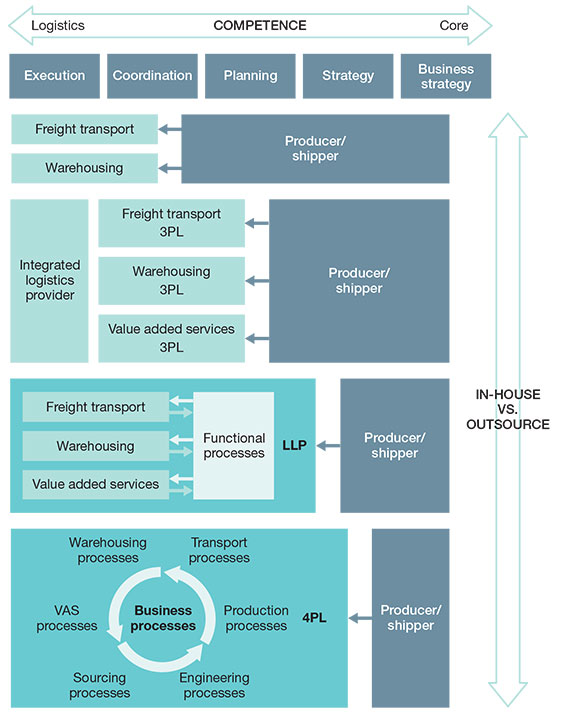Third-party Logistics: Critical to reimagining supply chain networks
Shippers and 3PLs can’t risk delaying a strategy to reimagine their future-proofed supply chain networks. With the role of the modern 3PL quickly expanding, it’s more important than ever for these partnerships to drive frictionless communication, unparalleled visibility, and two-way innovation amongst ecosystem partners.

Uncertainty is the only certainty for supply chains today. In fact, according to a recent BCI study, just in the past 12 months, almost 50% of supply chain operations reported six or more unique disruptive events. The ongoing disruptions and growing customer demands have shaped how shippers now respond in a world of constant chaos—reflecting the grit and determination of all the supply chain teams out there who worked to keep value chains open to move services and goods as best as possible.
Today, companies are at a tipping point with their supply chains of yesterday and are aggressively looking toward the reinvention of their business models through a future lens with supply networks that create durable competitive advantage.
This will require an ecosystem where shippers can better strategically leverage partner platforms and services to accelerate collaboration and transparency across the value chain. The age of the “cost transaction” between value chain players is fading away as shippers of all sizes continue to seek ways to bolster supply chain network resiliency, drive transparency, and move toward sustainable operations.
A key component of this is a shift toward deeper relationships with their third-party logistics (3PL) service providers and forging strategic innovative partnerships.
Accenture research shows 60% of executives are now trying to drive growth through building data transparent ecosystems, and three-quarters say that they need new ways of innovating with ecosystem partners to enable end-to-end visibility and a resilient supply chain network. Additionally, these new strategic partnerships are being shaped by business demands for a more comprehensive set of end-to-end logistics capabilities.
In fact, an Accenture survey found that 91% of logistics companies acknowledge that customers are now asking for end-to-end logistics services handled by a single provider. Companies that have established strategic third-party logistics provider relationships have already begun collaborating with their partners to rethink the foundation of their supply chains to design new supply networks with the customer at the center.
It’s through these deep partnerships, rooted in data rich analytics and connected ecosystems, that will allow industry leaders to reimagine how to leverage their value chain to launch new and innovated business models and achieve a true competitive advantage.
All of this means that 3PLs are more important than ever as companies push past the tipping point and into a brave new world.
Time to reimagine networks
For many companies, responding to disruption over the last two years was hard, messy, and complex. And now as the world has begun to pick up where it left off a few years ago, the rebalancing of supply with demand using tools, physical networks and assets has shifted from a controlled science to more of a magic trick requiring the juggling of needs to manage to the daily barrage of disruptions that are still affecting global value chains.
More and more companies are beginning to rethink and reimagine their current supply chains—seeking new strategies and frameworks to enable the next 10 years of growth. This pivoting from a necessary set of functional capabilities, sometimes loosely stitched together, into a new strategic competitive advantage that’s laser-focused on the customer, resilient and sustainable by design. And this is where 3PLs are needed to play a critical role in rebuilding global value chains.
The term “3PL” is indeed very broad. In the context here, it refers to any external partner that is being leveraged for some service, capability, or function in the supply chain network. In most cases, if there is a need, there’s a 3PL to step up and fill it, providing critical labor, assets, tools, and capabilities to deliver on customer demand.
Today, the speed to value of using a 3PL is probably one of the most important levers when considering new strategic needs in your future value chain. This is because of the simple fact that building capabilities in-house can be too slow, making it hard to respond to disruptions. And moving slow today is not an option.
Another strategic area of value that a 3PL can offer is the talent that is in high demand but with little supply—helping to bridge those gaps that have opened in the current war for talent.
Through strategic partnerships, critical skill needs can be served by better leveraging the deep expertise that the 3PLs hold—essentially “borrowing” them on demand by layering both business and 3PL resources into a shared operating model that delivers wins for the business, wins for the 3PL, and ultimately wins for the customer. It’s these types of new ways of working that will be the catalyst to new innovation that drives new growth and new value.

As we see more movement toward deeper, transparent partnerships, we are also seeing a shift by 3PLs to expand their service offerings in different ways to achieve the goal of becoming end-to-end service providers.
In fact, our research shows nearly half (48%) of logistics companies are pursuing vertical integration strategies. However, at the same time, 57% of logistics companies are challenged with funding to achieve their goals—creating yet another opportunity for deeper innovation partnerships that drive value for the business and the 3PLs through combined investments.
Getting it right with 3PLs
Gone are the days where viewing logistics activities and operations as commodities that only need tight cost management will suffice. This shifting mindset comes with new ideas and challenging discussions on how companies should adapt and create a logistics ecosystem that becomes integral to the growth-profit equation.
To do this, companies need to focus on the following three key things.
Leveraging the power of the network. One of the first fundamentals steps companies need to undertake is to rethink and re-architect a more flexible and connected supply network. To achieve this, companies are embracing asset light strategies and driving a higher demand for 3PL services—which is expected to see an 8.6% CAGR through 2030. This is opening the door even wider for those deeper innovation partnerships between businesses and 3PLs, delivering faster “idea-to-market” cycles to meet and capture first-mover advantages and establish real growth opportunities.
This requires the ability to ideate, test, and analyze a certain what-if scenario’s impact on the supply chain network without having to interrupt actual daily operations—and can be done with a stress test enabled by a digital twin.
Whether trying to understand the impact of changing raw material sources on transportation and inventory positions, a new lane bid for certain key lanes, a new sustainable EV last-mile fleet, or an entirely new warehouse flow, the power of what-if analysis using a digital twin can be a game changing advantage.

Data in the Cloud
For businesses to unlock the full value of a 3PL relationship, as well as enhance the understanding of their own supply chain network, strong integration is needed. Cloud technology enables decoupled systems to share data and analytics in real-time, allowing companies to maintain end-to-end visibility throughout their supply chain network.
Companies who deploy Cloud capabilities also reduce the impact of legacy systems that hinder investment into future emerging technologies. Giving companies the ability to scale connectivity within their own business as well as with their ecosystem partners. Executives on average attributed their Cloud use to a 26% increase in demand forecast accuracy, 16% reduction in supply chain operating costs, and a 5% increase in revenue growth and profitability.
There is one thing that supply chain networks generally have in plentiful abundance—data. The value of data is in how it is used to enable decisions and predict outcomes. This becomes difficult to accomplish if data is stored across disparate systems, hard to aggregate, and lacks ties to other related data across the business.
To truly leverage logistics as a competitive advantage, shippers must be able to access, harness, and present their data in ways that decision makers can quickly and confidently react to. This fast moving, predictive enabling process can help companies stay ahead of their demand, drive better resilience, and 3PLs are crucial to this.
Doing good together. We know that 60% of global emissions comes from supply chains. And we also know that customers are demanding trustworthy products. This is making sustainability the new “digital” and the momentum to build new value chains that are sustainable by design is not slowing.
Companies need to embed sustainability into everything they do and with everyone they work with—for shippers that includes things like shifting toward alternative fuels for fleets, renewable energy inputs to power network nodes, energy and waste optimization.
There is real value for 3PLs and companies to step up now and drive new innovations in this space to achieve the collective goals of operating supply chain networks responsibly, transparently, and with an intent of doing good for people and the planet.
Shippers and 3PLs can’t risk delaying a strategy to reimagine their future-proofed supply chain networks. With the role of the modern 3PL quickly expanding, it’s more important than ever for these partnerships to drive frictionless communication, unparalleled visibility, and two-way innovation amongst ecosystem partners.
By taking a balanced view across growth, profitability, sustainability, and diversity, companies can orchestrate the end-to-end experience their customer expect and deliver 360° value.

Article Topics
3PL News & Resources
LM Podcast Series: Assessing the freight transportation and logistics markets with Tom Nightingale, AFS Logistics Investor expectations continue to influence supply chain decision-making XPO opens up three new services acquired through auction of Yellow’s properties and assets FTR’s Trucking Conditions Index weakens, due to fuel price gains LM Podcast Series: Examining the freight railroad and intermodal markets with Tony Hatch Supply Chain Stability Index sees ‘Tremendous Improvement’ in 2023 TD Cowen/AFS Freight presents mixed readings for parcel, LTL, and truckload revenues and rates More 3PLLatest in Logistics
LM Podcast Series: Assessing the freight transportation and logistics markets with Tom Nightingale, AFS Logistics Investor expectations continue to influence supply chain decision-making The Next Big Steps in Supply Chain Digitalization Warehouse/DC Automation & Technology: Time to gain a competitive advantage The Ultimate WMS Checklist: Find the Perfect Fit Under-21 driver pilot program a bust with fleets as FMCSA seeks changes Diesel back over $4 a gallon; Mideast tensions, other worries cited More LogisticsSubscribe to Logistics Management Magazine

Find out what the world's most innovative companies are doing to improve productivity in their plants and distribution centers.
Start your FREE subscription today.
April 2023 Logistics Management

Latest Resources
















